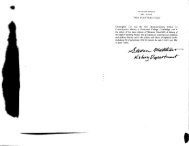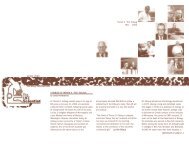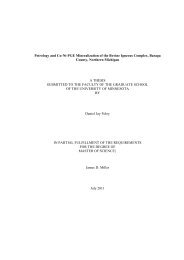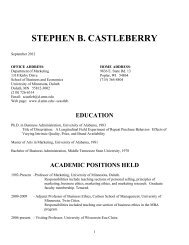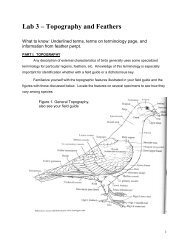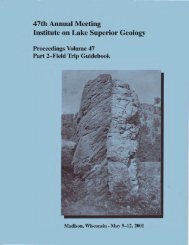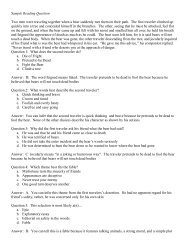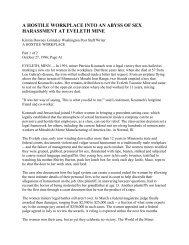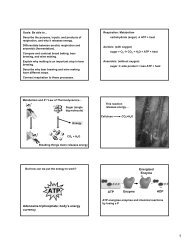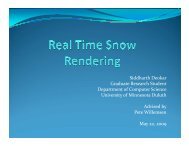Program, Abstracts, and Guidebooks - University of Minnesota Duluth
Program, Abstracts, and Guidebooks - University of Minnesota Duluth
Program, Abstracts, and Guidebooks - University of Minnesota Duluth
Create successful ePaper yourself
Turn your PDF publications into a flip-book with our unique Google optimized e-Paper software.
-16-<br />
A MODEL FOR TECTONIC VARIATION OF 'GRM4ITIC TERRAIN'<br />
IN SOUTHEASTERN MANITOBA<br />
I. F. ERMANOVICS<br />
Geological Survey <strong>of</strong> Canada, Ottawa<br />
A B ST RA CT<br />
The Precambrian rocks <strong>of</strong> the Superior (Structural) Province<br />
<strong>of</strong> southeastern Manitoba, between latitudes 51 <strong>and</strong> 54 degrees fall into<br />
three groups: metavolcanic—sedimentary rocks (domain I); an adjacent,<br />
hybrid mobile zone (domain II) <strong>and</strong> a siliceous (sialic) nucleus (domain III).<br />
Domain III, situated between 510 15' <strong>and</strong> 30' N, comprises<br />
augen-gneiss <strong>and</strong> weakly layered to stratiform layered gnefss (SO per cent<br />
<strong>of</strong> the domain) whose compositions range from quartz monzonite to gran—<br />
odiorite; mafic hornblende gneiss <strong>and</strong> amphibolite are abdundant locally.<br />
Siliceous mafic—noor quartz monzonite to granodiorite intrude these<br />
gneisses <strong>and</strong> the magnetite content <strong>of</strong> the massive rocks is correlatable<br />
to regional magnetic 'highs'. Metavolcanic—sedimentary rocks (3 per cent<br />
<strong>of</strong> domain III) <strong>and</strong> mafic granodioritic gneiss occupy relict keels <strong>of</strong><br />
folds; 'down—plunge' views <strong>of</strong> such structures show that these remnants<br />
are underlain by siliceous gneiss <strong>and</strong> massive rocks peculiar to rocks<br />
<strong>of</strong> domain III.<br />
Rocks <strong>of</strong> domain II, flanking belts <strong>of</strong> uietavolcanic—sedimentary<br />
rocks, consist <strong>of</strong> high—grade aluminoüs <strong>and</strong> inafic gneiss intruded by<br />
diapiric mafic granodiorite to quartz gabbro; large bodies <strong>of</strong> quartz<br />
monzonite are absent from this domain. The coarse—grained igneous rocks<br />
may be the intrusive equivalents (cogenetic magtnas) <strong>of</strong> the lavas <strong>of</strong><br />
domain I <strong>and</strong> both domains constitute the total volcanic—sedimentary<br />
tectogene.<br />
A seismic !break!, located along the lithologic boundary between<br />
domains II <strong>and</strong> III, indicates displacement <strong>of</strong> the Conrad discontinuity<br />
downward beneath domains I <strong>and</strong> II with respect to domain III. Thus if<br />
the seismic break is a fault (albeit annealed by later intrusions) <strong>and</strong><br />
if the volcanic—sedimentary tectogene is underlain by rocks <strong>of</strong> domain III,<br />
then the sialic nucleus (domain iii) is exposed by virtue <strong>of</strong> erosion.<br />
It is concluded that the volcanic—sedimentary rocks were<br />
deposited upon a sialic (relatively siliceous) basement which is now<br />
represented by !granitic gneiss'.




